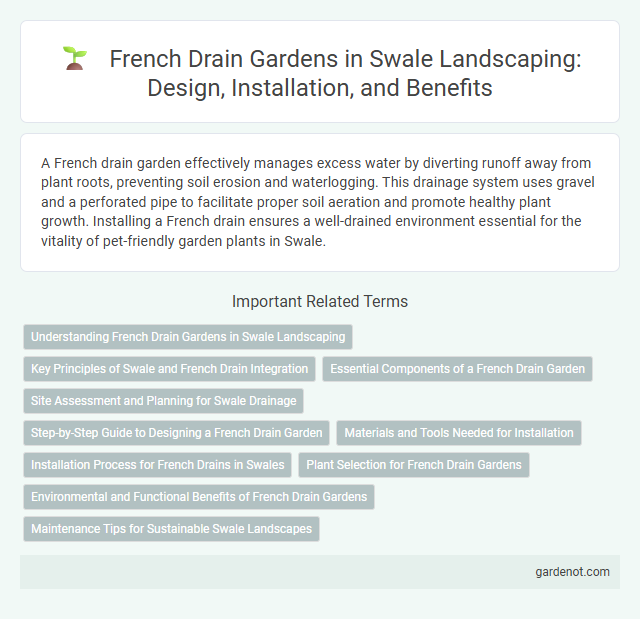A French drain garden effectively manages excess water by diverting runoff away from plant roots, preventing soil erosion and waterlogging. This drainage system uses gravel and a perforated pipe to facilitate proper soil aeration and promote healthy plant growth. Installing a French drain ensures a well-drained environment essential for the vitality of pet-friendly garden plants in Swale.
Understanding French Drain Gardens in Swale Landscaping
French drain gardens in swale landscaping enhance water management by efficiently redirecting excess surface runoff into underground drainage systems, preventing soil erosion and waterlogging. These gardens utilize gravel-filled trenches combined with perforated pipes, strategically installed along the swale's contour to facilitate controlled water flow and absorption. Integrating native or drought-resistant plants within the French drain garden promotes soil stabilization and supports sustainable landscape design in Swale environments.
Key Principles of Swale and French Drain Integration
Swale and French drain integration relies on the key principles of effective water management through controlled infiltration and drainage. Swales are shallow, vegetated channels designed to slow, capture, and infiltrate runoff, while French drains consist of perforated pipes surrounded by gravel to efficiently convey excess water away. Combining these systems maximizes groundwater recharge and prevents soil erosion, enhancing garden moisture retention and reducing surface water pooling.
Essential Components of a French Drain Garden
A French drain garden relies on essential components such as a perforated pipe, gravel or crushed stone bedding, and landscape fabric to ensure effective water redirection and drainage. The perforated pipe collects and channels excess water away from garden areas, while the gravel allows for proper water flow and filtration without clogging. Landscape fabric separates soil from the gravel, preventing sediment buildup and maintaining long-term drainage efficiency.
Site Assessment and Planning for Swale Drainage
Site assessment for swale drainage in French drain gardens requires analyzing soil permeability, slope gradient, and existing drainage patterns to ensure effective water flow and prevent pooling. Proper planning involves selecting appropriate swale dimensions and positioning to maximize infiltration and direct runoff away from structures. Integrating native vegetation along the swale enhances filtration and stabilizes the soil, improving overall drainage performance.
Step-by-Step Guide to Designing a French Drain Garden
Designing a French drain garden involves excavating a trench sloped at approximately 1% to 2% to ensure effective water flow. Line the trench with landscape fabric to prevent soil intrusion, then add a layer of coarse gravel before placing a perforated pipe to facilitate drainage. Cover the pipe with more gravel, wrap the fabric over the top, and fill the trench with soil or mulch, planting water-tolerant vegetation suited for managing excess runoff near swales.
Materials and Tools Needed for Installation
Installing a French drain garden in a swale requires perforated PVC pipes, landscape fabric, gravel, and sand for effective water drainage. Essential tools include a trenching shovel or excavator, a level to ensure proper slope, and a utility knife for cutting the fabric and pipes. Proper material selection and accurate trench depth help optimize water flow and prevent soil erosion in the swale area.
Installation Process for French Drains in Swales
Installing French drains in swales involves excavating a trench along the natural slope of the swale to facilitate water flow. The trench must be lined with landscape fabric to prevent soil infiltration, followed by placing a perforated pipe surrounded by gravel for optimal drainage. Proper backfilling with additional gravel and covering with soil or mulch ensures effective water management and reduces surface erosion in the swale area.
Plant Selection for French Drain Gardens
Choose deep-rooted, moisture-tolerant plants such as goldenrod, sedges, and switchgrass for French drain gardens to enhance water absorption and prevent erosion. Native species with high water uptake like joe-pye weed and swamp milkweed improve drainage efficiency and support local ecosystems. Incorporating diverse perennials ensures effective sediment filtration and promotes a balanced soil structure within the swale system.
Environmental and Functional Benefits of French Drain Gardens
French drain gardens effectively manage stormwater by directing excess runoff away from plant roots, reducing soil erosion and preventing waterlogging. These systems improve groundwater recharge and enhance soil permeability, promoting healthier plant growth and biodiversity. Installing a French drain garden also mitigates urban runoff pollution by filtering contaminants before water reaches natural waterways.
Maintenance Tips for Sustainable Swale Landscapes
Regular inspection of French drains in swale gardens prevents clogging and promotes efficient water flow. Clearing debris and flushing the system annually maintains permeability and reduces soil erosion. Using native plants around the swale enhances water absorption and supports long-term landscape sustainability.
French drain garden Infographic

 gardenot.com
gardenot.com